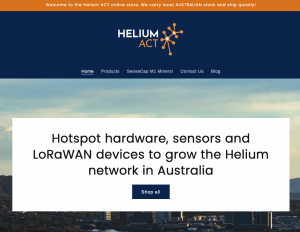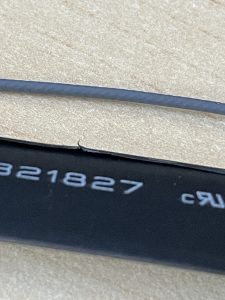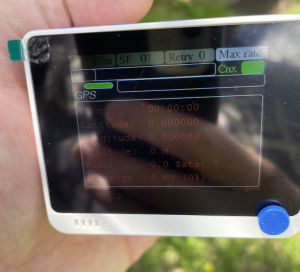With my Heltec CubeCell GPS boards seemingly configured as Helium Mappers – both with correctly configured mapping software and on the Helium Console, I set out with high expectations of being the first to map parts of the Helium network in Canberra and catch glimpses of our first hotspots here in the wild.
It felt like the old days of ‘wardriving‘ when Wifi first became a thing around a 100 years ago! 😉
First Attempt
HeliumACTMapper1 was the first one I tried. I plugged it into USB power in the car, chucked the mapper on the dashboard, grabbed my iPad loaded up and ready with Console and Cargo and headed in the direction of Turner and O’Connor.

The mappers boot up to a ‘joining’ mode, where they are seeking out a hotspot to speak to and to negotiate a connection to the Helium network. If I could get past this, that’d be a win.

I got close to where the hotspots are indicated on Helium Explorer map and parked the car. The display on the mapper still said ‘Joining‘ and I got disheartened, despite the warnings it can take 3-20 minutes to join. I browsed the forums on the iPad looking for answers and learned that I had the antenna plugged into the wrong receptacle.
The Helium CubeCell GPS ASR6502 has two tiny, identical, unmarked IPEX antenna connectors in identical positions (just on different sides of the boards. The top receptacle next to the OLED display is the correct one for the supplied LoRaWAN antenna. The one on the reverse side and funnily enough next to the GPS chip is for the GPS antenna, which I didn’t have.

I connected the antenna properly, waited a couple more minutes since I had an antenna that should be doing some good, glanced at the display again to see it had changed from ‘Joining‘ to ‘GPS Searching‘. Success?
I quickly flipped to the Helium Console to see that sure enough, my mapper had found Generic Wooden Loris and had successfully connected and registered to the Helium network. Woohoo! The Console now shows a green dot next to the tracker and several data packets had been transmitted – a big win for sure – but none of the packets had made it to the Helium Mapper.

The board continued to display ‘GPS Searching’ so I moved it around the dash, attempting to orient the board-mounted GPS antenna upwards.
Round Two – GPS Searching
With HeliumACTMapper2 also flashed, battery powered and ready to go, worried that the GPS signal wasn’t getting through the windscreen glass, I decided I had to give the onboard GPS antenna the greatest chance of success by opening the sunroof of the Golf and cable tying the two mappers – onboard GPS antennas facing skyward – both to the sunroof spoiler to give it the greatest chance of a GPS lock.


I drove 20 mins or so to the same location and waited. HeliumACTMapper2 successfully connected to the hotspot and was now registered in Helium Console, but BOTH mappers still sat there ‘GPS Searching‘. I drove around a bit more and finally gave up for the day, concluding that I needed an antenna and to understand the problem better.

Learnings
While disappointed I had contributed no mapping data today I learned several things:
- I’m confident I know how to set up devices in the Helium Console – THAT bit worked at least
- The Helium Console is slick and easy to use
- GPS antenna is a must – I didn’t get a GPS lock all day. I have a couple ordered from AliExpress I just hope they arrive sooner rather than later.
- I’m not convinced the GPS Mode settings for the mapper are correct for Australia. They default to GPS + GLONASS, but we have access to the GALILEO GPS satellites down here – I’m reading through some of this info to see how to best change that
- I never caught site of Real Mercurial Crocodile once
Stay tuned for the next attempt and for another post where I talk about my experience getting these boards configured. We’ll get there…
UPDATE:
I played around with this some more over the weekend, and had some success – I wrote up what I learned here.







